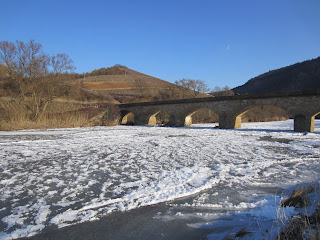 |
| Vineyards above Oberhausen an der Nahe |
There aren't many wineries who have the benefit of being located in a medieval 12th Century chateau, but Schlossgut Diel is one them. Rather than use the term Weingut, they take their name from the word Schloss meaning chateau. The winery has been owned by the family since 1802 when it was purchased after the Napoleonic re-appropriation of land and titles in the region. For the past 200 years they have established a reputation as one of the finest producers in the region, specialising in single vineyard expressions of riesling, but also other varieties including pinot blanc (weisburgunder), pinot gris (grauburgunder) and pinot noir (spatburgunder). Caroline Diel welcomed me to the estate, and we took a tour down into the cellars which have been artistically decorated by the German artist Johannes Helle since 1987. Here we saw painted steel tanks and traditional Nahe barrels that hold about 1100 litres each.
Compared to many of the rieslings I tried in the Mosel, the Nahe wines of Schlossgut Diel are brighter, zingier and slightly spritzy in nature. They don't have the same minerality or the focus of the Mosel, but this may be a product of the vintage. There was a lovely consistent line between all the wines of grapefruit, which suggests to me the wines are made essentially the same, just the entry-level wines being blends of different vineyards. The trocken wines were particularly good; I think I liked them better than the dry wines of the Mosel. As a member of the VDP Diel use the vineyard classification system, so tasting the Grosses Gewachs wines was an experiment in more concentrated and austere characters. The 2010 wines had a similar nature in the Nahe as the Mosel, of higher acids and sugar so they are very crisp and citrussy in their acids. The Goldloch Spatlese was very complex and slightly savoury, showing some interesting crushed herb elements. We finished with a rose made from pinot noir, which was slightly spritzy and had 10g/L of residual sugar, so was very pleasant and easy to drink.
 |
| Caroline Diel |
 |
| Check out the trockenbeerenauslese fermenting in the office |
Click here to see more photos from the Nahe, Germany.


No comments:
Post a Comment